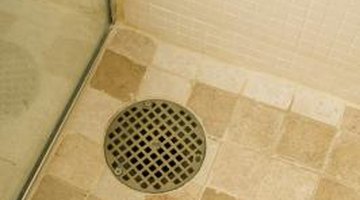Does a Shower Drain Need to Be in the Center?
Whether a drain is installed in a basement floor, sink, tub or shower, it has to be at the lowest point to be effective. To properly locate a shower drain, a stall manufacturer or tiler molds the base so that it has a continuous downward slope from the edges toward the drain. This doesn't mean the drain has to be in the center, however, and offset drains are common in prefabricated and custom stalls alike.
Slope Requirements

Wherever the drain is located on the base of the shower stall, the base must slope toward it from all directions. The requirements for the amount of slope aren't always specified, but making it too steep can create a slipping hazard. A slope of 1/8 inch per foot is usually enough to provide adequate draining in a molded base, and some local codes may specify a steeper slope of 1/4 inch per foot for a tile shower. The slope does not have to be uniform at every point on the base, but it should be uniformly directed to the drain.
Setting Drains
When you are fabricating your own shower stall, you can place the drain at any location on the base as long as you slope the floor toward it. Some builders bend plywood to form a sloping base by making a series of cuts in the back and screwing it to shims, while others use mortar. They lay the plywood after installing the drain and form it carefully toward the drain, using a level to measure the slope as they work. The latter is the more reliable method to produce a substrate for tile or stone.
Prefabricated Shower Stalls
Prefabricated shower stalls have molded bases that slope toward the drain, and the drains are not always located in the middle. The stall will only drain correctly, however, if you install it level and it can't move. Many stalls come with supports that allow for installation on nothing more than a level subfloor, but others require the installation of extra support, usually in the form of wooden shims nailed to the subfloor. Supports must be secure or the base may shift and water will collect instead of going down the drain.
Considerations
An offset drain is an advantage in many situations. If the stall has a bench, placing the drain under the bench will keep it from underfoot. You can also keep the drain out of the way by placing it in a corner or near the door. If you are building your own stall, one critical requirement is that the base be free of irregularities. If there are any high or low spots that prevent water from flowing to the drain, wherever it is located, the water will collect and present a slipping hazard.
References
Writer Bio
Chris Deziel has a bachelor's degree in physics and a master's degree in humanities. Besides having an abiding interest in popular science, Deziel has been active in the building and home design trades since 1975. As a landscape builder, he helped establish two gardening companies.
Photo Credits
- Jupiterimages/Photos.com/Getty Images
More Articles


